‘Big Carl’: How to handle the world’s biggest crane at Hinkley Point
29 September 2021
Ashley Daniels, the head of lifting at Hinkley Point C, tells Lucy Barnard how it feels to be the man in charge of the world’s biggest and most powerful crane. Photos courtesy of EDF.
Although dozens of tower cranes cluster against the horizon at Hinkely Point C, the world’s biggest and strongest land-based lifting machine stands metaphorically head and shoulders above the rest.
On a grey September morning, the bright yellow and blue livery of the SGC250 can be seen clearly against the rolling green hills surrounding Britain’s largest and most complex civil engineering project since the second world war.
Five years after construction work started at the nuclear power station mega project, Ashley Daniels, the head of lifting and temporary works, proudly reels off a list of superlatives associated with the giant he affectionately knows as ‘Big Carl’
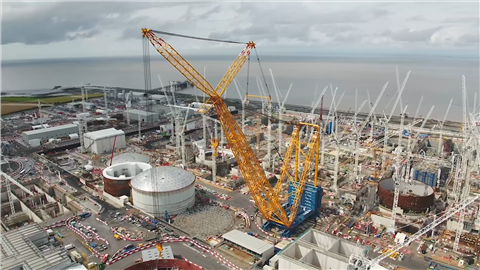 Big Carl rises above the tower cranes at Hinkley Point C - photo courtesy of EDF
Big Carl rises above the tower cranes at Hinkley Point C - photo courtesy of EDF
Not only is ‘Big Carl’ the world’s strongest land-based crane, able to carry 5,000 tonnes in a single lift, according to manufacturer Sarens. But the giant lattice boom crane is also the tallest. Big Carl’s main boom can be extended from 118 metres to 160 metres and its jib can be extended to 100 metres, giving him a maximum height of 250 metres, nearly as tall as the Commerzbank Tower in Frankfurt.
In fact, ‘Big Carl’ is such a beast that the machine is frequently referred to by the Hinkley Point team and main contractor BYLOR in anthropomorphic terms as ‘he’ rather than ‘it’.
Named after Carl Sarens, the director of global operations and technical solutions at Belgian crane manufacturer Sarens, since he arrived on site in 2019, Big Carl, has received much of the site’s media attention.
“Big Carl undertakes the large significant lifts,” says Daniels. “It’s a massive benefit to have such a crane on the project with incredible capacities at massive radiuses.”
These ‘significant’ lifts so far have included moving into position two of the three 47-metre wide prefabricated steel rings which will eventually form the first of two nuclear reactors on site.
Big Carl’s lifting equipment
The second of these ‘liner rings’ included a total weight of 544 tonnes – although a significant proportion of that included Big Carl’s own lifting equipment; a ring weight of 347 tonnes, a hook block weighing 58 tonnes, a novabeam of 72 tonnes and tackle and chains weighing 66 tonnes.
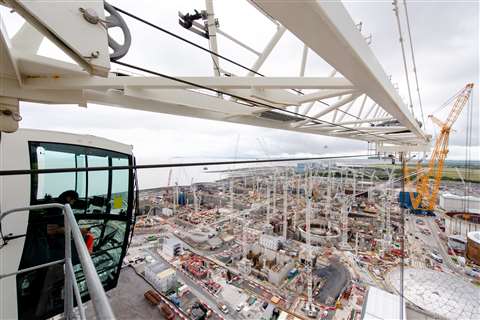 A bird’s eye view from one of the tower cranes across one of Europe’s largest construction sites - photo courtesy of EDF
A bird’s eye view from one of the tower cranes across one of Europe’s largest construction sites - photo courtesy of EDF
And, Daniels points out that there is far more work for Big Carl to do on site than that. To date, the mega machine has completed 301 lifts at Hinkley Point C, carrying anything from rebar cages to items of equipment.
On 15 September Big Carl lifted a whopping 388 tonne pre-cast slab of concrete and rebar steel from the central pre-cast yard to the East Pool Bunker to be integrated into the unit 1 area. When combined with the 118 tonnes of lifting accessories it took to move the load, the total weight stood at 506 tonnes.
But, like any good manager, keen to keep his star player in check, Daniels points out that Big Carl is still just part of the team – a sort of star striker who only touches the ball a few times a game. He only usually undertakes around 20 of the 1,000 lifts a month completed by the team of around 50 tower cranes.
“Big Carl wasn’t deployed on Hinkley Point C to undertake multiple small lifts a day, but to lift significant large components, pre-cast concrete slabs, rebar cages and equipment,” says Daniels. “Big Carl will only do one or two lifts per day at best, moving the pre-cast elements. He has the capacity to do many more, with the Sarens and BYLOR team ready and waiting.”
In fact, despite Big Carl’s capabilities, the Hinkley team says that they don’t actually use many of his snazzier functions.
When it comes down to it, Daniels says, getting Big Carl into the right position for each lift can take hours, often using a smaller crane or “slave crane” to build him and assemble the rigging equipment.
As with most cranes, the operator sitting in Big Carl’s cab still relies on communicating with his team via a two-way-radio to lift loads.
Communicating with secure radios
“Big Carl’s operator won’t see a great deal from the cab, taking into consideration the size and scale of the items he will lift,” Daniels says. “The operator relies on the slinger signaller and lifting supervisor to be his eyes and ears on the ground. They communicate with secure radios because they can’t be interfered with when relaying communications.”
What is Hinkley Point C?
Hinkley Point C in Somerset, England, will be the first nuclear power station to be built in Britain for 20 years. When completed, the twin unit EPR (Evolutionary Power Reactor) will be capable of generating 3,260MW of electricity for 60 years.
The project is being built by EDF Energy. The main contractor on the site is BYLOR, a joint venture of Bouygues Travaux Publics and Laing O’Rourke.
Big Carl can move around the site on his own 6km long railway tracks carrying loads to three different lifting positions comprising 48.5 metre turning circles and spin around completely, making him the only crane in the industry able to relocate fully rigged, from one spot to another. But, in actual fact, Big Carl is too slow and lumbering to be really useful in carrying loads around the site very often.
“In general a tower crane can do a complete 360 degree turn in less than a minute,” says Daniels. “It takes Big Carl over 30 minutes to do the same thing. It takes Big Carl around nine hours to move between lifting points (three lifting circles) so we tend to use SPMT [self-propelled modular transporter] trailers to move loads around the site.”
Marr Contracting
It was a similar story with another of the Top Trumps of cranes also used at Hinkley Point C, a Favelle Favco M2480D. This crane, which Australian supplier Marr Contracting used to install one of the giant machines used to drill tunnels deep under the site boasted the title of the world’s largest capacity tower crane.
The crane which can extend up to 76 meters, has a capacity of 25 tonnes at a 100m radius and a maximum capacity of 220 tonnes in this configuration, occupying a smaller area than a similar sized crawler crane and carrying out heavier lifts.
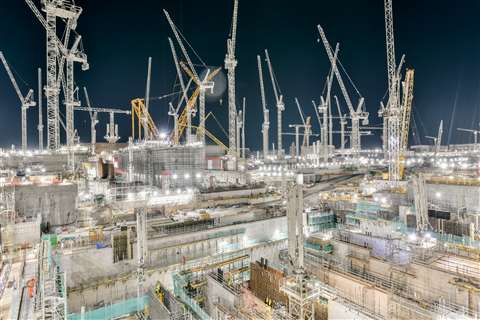 Looking back across the 36m ‘deep dig’ of Hinkley Point C’s pump house to the turbine building and crane, Big Carl.
Looking back across the 36m ‘deep dig’ of Hinkley Point C’s pump house to the turbine building and crane, Big Carl.
But, although it was fit for purpose and had good compliances, the fact that it required a a Liebherr LTM 11200 mobile crane to set it up and frequent refuelling with diesel caused some headaches. Fittingly for a site building one of the largest generators in Europe, nearly all the cranes at Hinkley Point C are powered by electricity.
Although the Favelle Favco M2480D did its job in getting the TMB into position, the Hinkley lifting team in fact managed to lift a second TBM using crawler cranes instead and found it could do the job just as well and significantly faster.
But, even if some of the record breaking cranes have not always been as effective at some of the work than more traditional lifting methods, Daniels says that Hinkley Point C’s cranes are achieving new firsts in other ways too.
BYLOR and Grafana
One of the most important of these is through the use of data on site.
By using Grafana, a crane telemetry platform developed by contractor BYLOR, Daniels says that, at the touch of a button, all crane users on site are able to share key information about the machines they are using in real time and coordinate usage.
After just a few clicks on his laptop, Daniels is already accessing screens and screens of data, giving current wind speeds, average number of lifts, and even the time of the daily changeover between the day shift and the night shift on each machine.
Construction at Hinkley: The story so far
Work on the site started on 29 September 2016.
In January, EDF announced that delays arising from the pandemic would increase the cost of the project by £500 million to £23 billion and delay the start of electricity generation from unit 1 by six months to June 2026.
So far two of the three prefabricated 17 metre high sections of the first reactor building have been erected and a third is ready to be lifted into place.
Work to build a 16 metre high floor for the first turbine and generator is under way and a first turbine is expected to arrive later this year. three and a half miles of cooling tunnels have been completed.
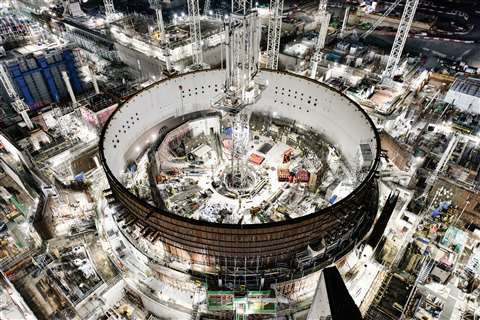 Reactor unit 1 taking shape as work continues around the clock.
Reactor unit 1 taking shape as work continues around the clock.
“Once I’ve accessed the platform, I can select a geographical area on site and select the desired crane,” he says, selecting a Pontain MD509 tower crane from an on-screen digital map. “The dashboard displays multiple charts and diagrams from wind speed to loads that have been lifted. The crane selected has undertaken 14 lifts in the last 24 hours. The heaviest of those was 2 tonnes. In fact, it has done seven 2 tonne lifts.”
And, as more and more contractors start to come onto site and require access to the site’s tower cranes, Daniels says that the new technology will make it easier for his team to manage crane usage and let contractors book the cranes they need.
“We have multiple contractors on site with the requirement to use the tower cranes. Before the platform was developed by BYLOR and adopted by the project, we would really be going off word of mouth or paper records,” he says.
And that’s not the only tech package in use on the Hinckley Point cranes. Daniels also proudly points to the anti-collision software developed by French firm ACMS which is in use on the site and a package called Crane Booker, developed by DataScope Systems.
“If several contractors have the requirement to use the same tower crane at the same time we have the capacity to plan, manage and coordinate lifting activities effectively with Crane Booker and the Grafana dashboard. The project management teams act as the gate keeper and penultimate approver deciding which lift to undertake first to best meet the project’s schedule. Having activities managed digitally allows a more collaborative and transparent approach. Each contractor has the facilities to request the use of the tower cranes on site with BYLOR operating and maintaining the cranes. It means they can select the right crane and all be on the same page.”
Hinkley Point C’s biggest challenge
Hinkley Point C’s Yet, perhaps the biggest challenge faced by the teams at Hinkley Point C since work began five years ago has not been the huge lifting weights or complicated technology but rather the problems presented by the Covid pandemic.
Although construction work never stopped, Daniels says that the team had to make provisions to stop work completely if lockdown regulations were strengthened, leaving just a maintenance team on site.
As it was, the team managed to reduce the number of people on site by ensuring that around 70% of office staff worked from home. These included people who would ordinarily have been on site such as engineers reviewing lift plans.
Covid tests are mandatory for anyone coming to site and strict covid safety protocols have been introduced for those on site.
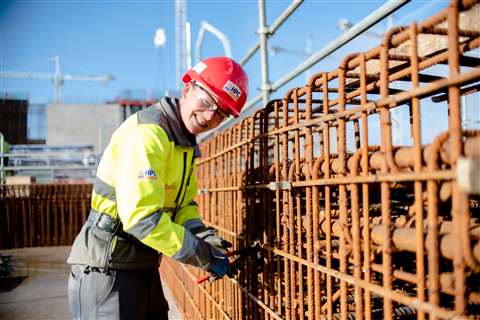 A total of 787 apprentices have been trained so far at Hinkly Point C - photo courtesy of EDF
A total of 787 apprentices have been trained so far at Hinkly Point C - photo courtesy of EDF
“These have been difficult complex times,” says Daniels. “We had to consider minimum staffing levels to undertake the lifting activities safely and effectively. Each lift requires key individuals to be present on site as detailed within the contractors’ pre-approved lift plans that have been developed to meet the project lifting standards.”
“These include crane operator, supervisor, slinger signaller, AP [appointed person] and crane co-ordinator if and when required. We also reviewed and implemented working remotely for the individuals that could undertake working duties at home effectively, minimising the demand on the project resources such as bussing and canteen requirements.”
And so, with delays arising from the pandemic pushing up costs to an estimated £23 billion and postponing the planned start of electricity generation from unit one until June 2026, pressure on construction crews at Hinkely Point C is likely to build.
At the start of the year, Hinkley Point C managing director Stuart Crooks told employees that the company’s ambition to lift the first dome on Unit One by the end of 2022 “remains unchanged”, and said the project is experiencing “a health crisis, not a problem with construction”
•‘Big Carl’ is otherwise known as a SGC250 - the letters stand for ‘Sarans Giant Crane’
•He is named after Carl Sarens, the director of global operations and technical solutions at Belgian crane manufacturer Sarens.
•Big Carl is the world’s strongest land-based crane, able to carry 5,000 tonnes in a single lift.
•Big Carl’s main boom can be extended from 118 metres to 160 metres and its jib can be extended to 100 metres, giving him a maximum height of 250 metres and making him the tallest crane in the world
STAY CONNECTED



Receive the information you need when you need it through our world-leading magazines, newsletters and daily briefings.
CONNECT WITH THE TEAM








